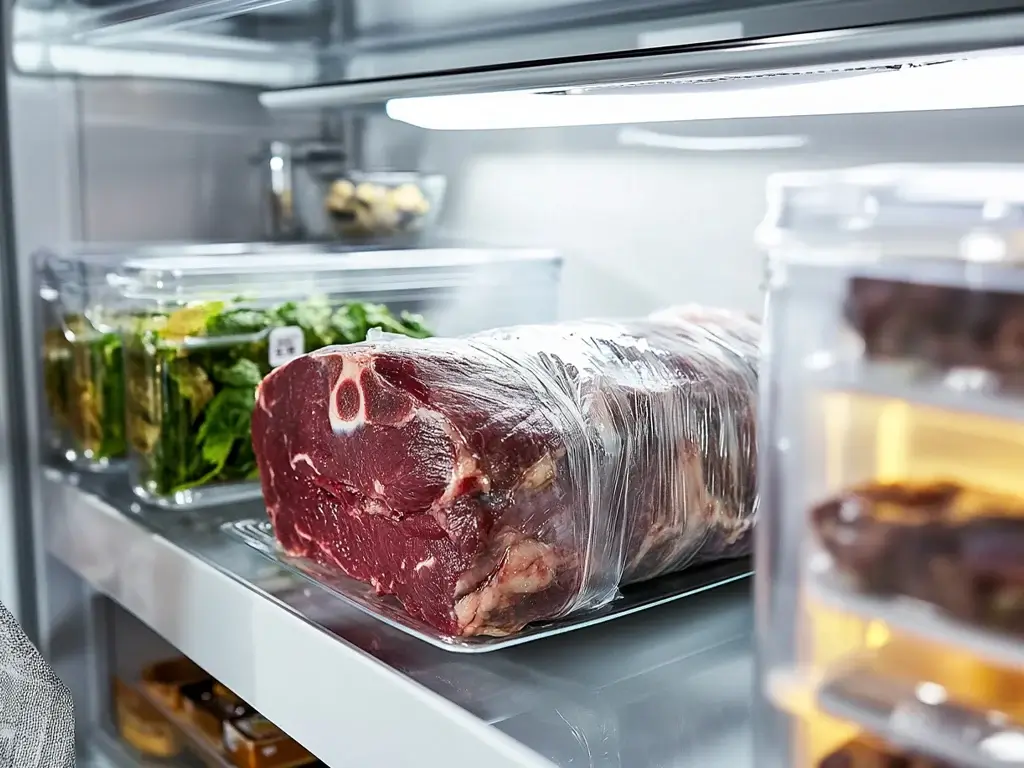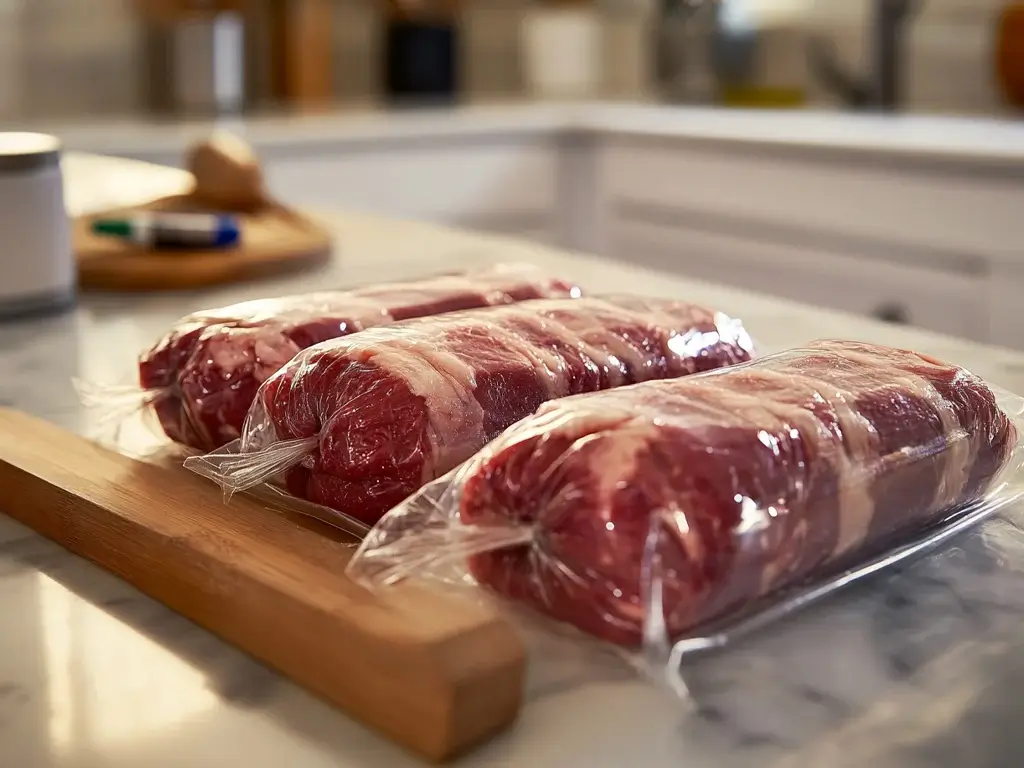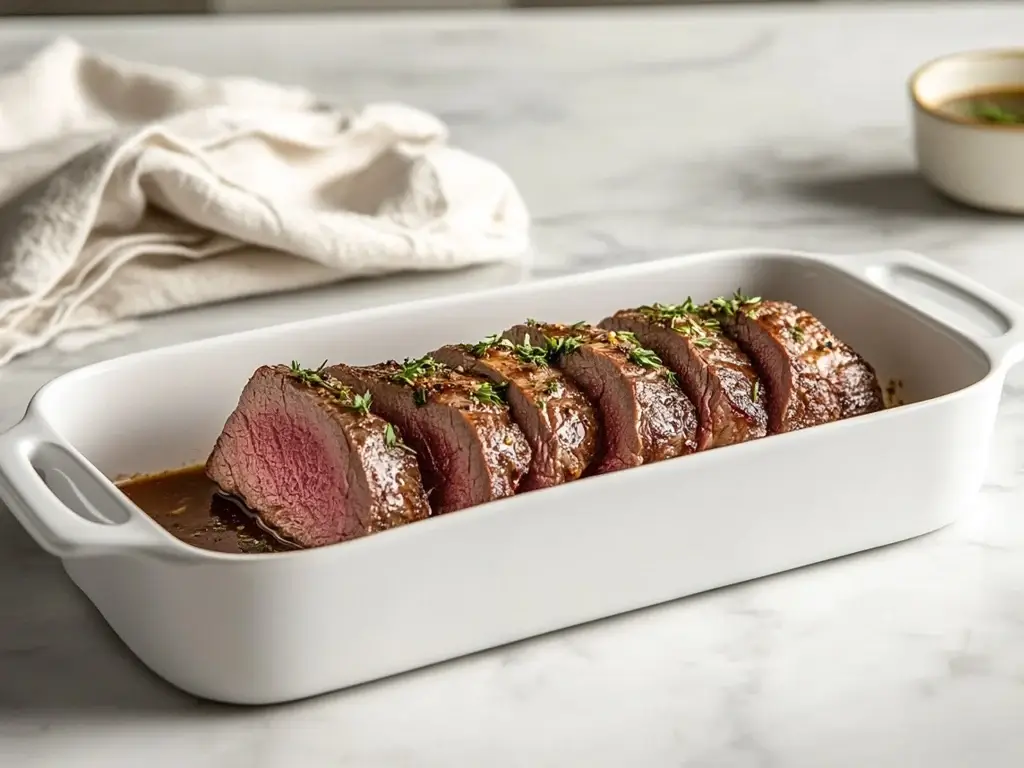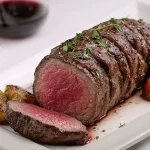Beef tenderloin is a prized cut of meat, celebrated for its tenderness and rich flavor. Whether it’s served at a festive gathering or a special dinner, leftover beef tenderloin can be a delicious treat for days to come—if stored and handled properly. For creative ways to enjoy your leftovers, check out these leftover beef tenderloin recipes. But just how long does leftover beef tenderloin last? Understanding the fundamentals of proper storage is key to keeping your leftovers fresh, safe, and enjoyable. This article delves into the essentials of handling, refrigerating, and understanding the shelf life of this exquisite cut of beef.
Table of Contents
Understanding Beef Tenderloin Storage Basics
Leftover beef tenderloin requires careful attention to ensure its quality and safety. From the moment it leaves the dinner table to when it’s stored, every step matters. Improper handling can lead to spoilage, waste, and even foodborne illnesses. To keep your leftovers at their best, it’s crucial to follow a few basic storage guidelines.
Proper Handling of Cooked Beef Tenderloin
The way you handle cooked beef tenderloin plays a significant role in its longevity. Start by ensuring the meat is cooled to room temperature within two hours of cooking. Leaving it out for longer can expose it to the temperature danger zone (40°F to 140°F), where bacteria multiply rapidly.
To store it, wrap the tenderloin tightly in aluminum foil, plastic wrap, or place it in an airtight container. Avoid cross-contamination by keeping it separate from raw foods in the refrigerator. These practices not only maintain the meat’s flavor and texture but also prevent the growth of harmful bacteria.
Importance of Refrigeration for Leftovers
Refrigeration is your best friend when it comes to preserving leftover beef tenderloin. Ideally, it should be stored at a temperature below 40°F (4°C) to slow bacterial growth. Place the meat on the upper shelf of the fridge, where the temperature is consistent, and consume it within 3 to 4 days for optimal freshness.
For longer storage, consider freezing the leftovers. Beef tenderloin can last up to 3 months in the freezer without losing its quality, provided it’s wrapped securely to prevent freezer burn. Label the package with the date to track how long it’s been stored.
Key Factors Affecting Shelf Life
Several factors determine how long your leftover beef tenderloin will last:
- Temperature: Consistently storing beef at the right temperature is vital. Fluctuations can accelerate spoilage.
- Moisture Control: Proper wrapping prevents the meat from drying out or becoming soggy, which can affect its texture and taste.
- Initial Quality: The freshness of the tenderloin before cooking also influences its shelf life. Fresh, high-quality meat tends to last longer.
- Storage Conditions: Cleanliness and organization in the refrigerator reduce the risk of cross-contamination.
By understanding these basics, you can enjoy your leftover beef tenderloin for days without compromising safety or flavor.
How Long Does Leftover Beef Tenderloin Last? Storage Duration Guide

When it comes to preserving the deliciousness of leftover beef tenderloin, knowing how long it lasts is crucial. Proper storage ensures both safety and flavor, giving you more opportunities to savor this exquisite cut. Let’s explore the guidelines for storing beef tenderloin effectively.
How Long Beef Tenderloin Lasts in the Refrigerator
Leftover beef tenderloin can be safely stored in the refrigerator for 3 to 4 days when handled properly. To achieve this, the meat should be cooled to room temperature and refrigerated within two hours of cooking. The consistent cool temperature of the refrigerator slows bacterial growth, helping maintain the meat’s quality and safety.
Always keep the tenderloin in an airtight container or wrap it tightly in aluminum foil or plastic wrap. This protects it from exposure to air, which can dry out the meat and compromise its flavor. It’s also a good idea to label the storage container with the date, ensuring you don’t exceed the recommended time frame.
Optimal Temperature for Refrigerated Storage
For best results, set your refrigerator to a temperature below 40°F (4°C). This is the ideal range to keep beef tenderloin fresh while preventing bacterial growth. Place the leftovers on the upper shelves where the temperature is most consistent. Avoid storing them in the refrigerator door, as frequent opening can cause temperature fluctuations.
Freezing Leftover Beef Tenderloin: Tips and Tricks
If you want to extend the shelf life of leftover beef tenderloin beyond a few days, freezing is your best option. When frozen correctly, tenderloin can last up to 3 months without losing its flavor or texture.
- Cool Before Freezing: Allow the meat to cool completely before freezing. Freezing warm tenderloin can create ice crystals that degrade the texture.
- Wrap It Right: Use heavy-duty aluminum foil, freezer-safe plastic wrap, or vacuum-sealed bags to protect the tenderloin from freezer burn. Double wrapping is recommended for added protection.
- Portion Control: Divide the tenderloin into meal-sized portions before freezing. This makes it easier to thaw only what you need.
Maximizing Freshness in the Freezer
To ensure the best quality, label your frozen tenderloin with the storage date. When you’re ready to enjoy it, thaw the meat in the refrigerator overnight. Avoid thawing it at room temperature, as this increases the risk of bacterial growth. Once thawed, consume the tenderloin within 24 hours for optimal taste and safety.
Signs of Spoilage in Leftover Beef Tenderloin
Even with proper storage, it’s essential to check your leftover beef tenderloin for signs of spoilage before consuming it. Here are key indicators:
- Unpleasant Odor: A sour, rancid, or ammonia-like smell is a clear sign of spoilage.
- Slimy Texture: If the surface of the meat feels sticky or slimy, it’s time to discard it.
- Discoloration: While slight browning is natural, green or gray hues indicate bacterial growth.
- Off Taste: If the meat tastes off or unusual, it’s better to err on the side of caution and not eat it.
By keeping these storage tips and spoilage signs in mind, you can enjoy your leftover beef tenderloin safely and deliciously.
Proper Methods for Storing Beef Tenderloin

Storing beef tenderloin properly is essential to preserving its taste, texture, and safety. With the right techniques, you can ensure your leftover tenderloin remains as mouthwatering as the day it was prepared. Let’s dive into the most effective methods for storing this prized cut.
Using Airtight Containers for Refrigeration
Airtight containers are a simple yet effective way to keep beef tenderloin fresh in the refrigerator. These containers create a barrier against air, which can dry out the meat and compromise its flavor. Here are some tips for using airtight containers effectively:
- Choose the Right Size: Use a container that fits the tenderloin snugly, minimizing excess air space.
- Layer Protection: Wrap the tenderloin in plastic wrap or aluminum foil before placing it in the container for added freshness.
- Label the Container: Clearly mark the storage date to track how long the beef has been refrigerated.
By using airtight containers, you can keep your beef tenderloin fresh for up to 3 to 4 days in the refrigerator.
The Role of Vacuum Sealing in Prolonging Shelf Life
Vacuum sealing is a game-changer when it comes to extending the shelf life of beef tenderloin. This method removes all the air around the meat, drastically reducing the risk of bacterial growth and freezer burn. Here’s how vacuum sealing can help:
- Extended Refrigeration Time: Vacuum-sealed tenderloin can last up to a week in the refrigerator.
- Ideal for Freezing: In the freezer, vacuum-sealed tenderloin retains its quality for up to 6 months, significantly longer than traditional wrapping methods.
- Preserved Flavor and Texture: Without exposure to air, the tenderloin maintains its original taste and tenderness.
Investing in a vacuum sealer is a smart choice if you frequently store high-quality meats like beef tenderloin.
Wrapping Techniques for Freezing
Freezing is the best option for long-term storage, but the wrapping technique you use can make or break the quality of your beef tenderloin. Follow these steps for optimal results:
- Double Wrapping: Start by wrapping the tenderloin tightly in plastic wrap or aluminum foil. Then, place it in a freezer-safe zip-top bag or wrap it again in heavy-duty aluminum foil.
- Remove Air: If you don’t have a vacuum sealer, press as much air out of the packaging as possible before sealing.
- Portion Control: Divide the tenderloin into individual servings before freezing to make thawing easier and reduce waste.
- Labeling: Always label the packaging with the date of freezing and any additional details, like seasoning or marinade.
When stored properly, frozen beef tenderloin can maintain its quality for up to 3 months. To enjoy it at its best, thaw it in the refrigerator overnight and consume it within 24 hours.
By mastering these proper storage methods, you’ll not only extend the life of your beef tenderloin but also ensure every bite is as flavorful and safe as the first.
Reheating Leftover Beef Tenderloin Safely

Reheating leftover beef tenderloin is an art that requires care to ensure the meat retains its original flavor, texture, and succulence. With the right methods, you can bring this premium cut of beef back to life without compromising its quality.
Best Practices for Maintaining Flavor and Texture
Maintaining the flavor and texture of beef tenderloin during reheating starts with gentle and consistent heat. Here are some tried-and-true practices:
- Low and Slow: Reheat the tenderloin at a low temperature, around 250°F (120°C), in the oven. This gradual heating prevents the meat from drying out or overcooking.
- Add Moisture: To retain the juiciness, place a small bowl of water in the oven alongside the meat or cover the tenderloin loosely with aluminum foil. This creates a steam effect that keeps the beef moist.
- Use a Meat Thermometer: To avoid overcooking, use a thermometer to check the internal temperature. Reheat until it reaches 130°F (55°C) for medium-rare or 140°F (60°C) for medium.
- Preheat Properly: Ensure the oven or pan is preheated to the desired temperature before reheating. This helps the tenderloin heat evenly.
Following these best practices ensures that your beef tenderloin tastes as delicious as it did the first time around.
Avoiding Overcooking During Reheating
Overcooking is the biggest risk when reheating beef tenderloin. It can turn this tender cut into a tough and chewy disappointment. To avoid this:
- Choose the Right Method: Opt for oven reheating rather than using a microwave, which often heats unevenly and can dry out the meat.
- Slice Before Reheating: If you plan to serve smaller portions, slice the tenderloin before reheating. This reduces reheating time and prevents overcooking.
- Cover Lightly: Use aluminum foil or a lid to cover the meat while reheating. This traps moisture without making the meat soggy.
- Monitor Closely: Keep an eye on the tenderloin as it reheats. The process should take no more than 20–30 minutes in the oven, depending on the portion size.
For a quicker option, you can also use a stovetop method. Heat a skillet over low heat, add a splash of beef broth or water, and gently warm the tenderloin slices for a few minutes.
By following these guidelines, you can enjoy reheated beef tenderloin that’s just as tender and flavorful as the first time it was served.
Frequently Asked Questions
How to eat leftover beef tenderloin?
Leftover beef tenderloin can be enjoyed in a variety of ways. Slice it thin and serve it cold over a crisp salad for a refreshing meal, or warm it gently to use in sandwiches, wraps, or tacos. You can also dice it and toss it into a stir-fry, pasta dish, or scrambled eggs for a protein-packed twist. The versatility of beef tenderloin makes it a delightful addition to countless recipes. Learn more
What to do with beef tenderloin scraps?
Don’t let those flavorful scraps go to waste! Beef tenderloin scraps can be transformed into delicious meals. Use them to make beef stock or broth by simmering them with vegetables and herbs. They’re also perfect for creating a hearty beef stew or adding a rich flavor to soups. For a quick snack, sauté the scraps with garlic and onions, and pair them with rice or potatoes. Learn more
Can you reheat cooked beef tenderloin?
Yes, cooked beef tenderloin can be reheated successfully if done properly. Use a low-temperature method, such as reheating in the oven at 250°F (120°C), to maintain its tenderness. Avoid the microwave, as it can overcook and dry out the meat. For more detailed reheating tips, refer to the earlier section on Reheating Leftover Beef Tenderloin Safely. Learn more
How long can cooked beef tenderloin stay at room temperature?
Cooked beef tenderloin should not be left at room temperature for more than two hours. Bacteria multiply rapidly between 40°F (4°C) and 140°F (60°C), making it unsafe to consume if left out for too long. Promptly refrigerate any leftovers to maintain their quality and safety.
Can you freeze beef tenderloin after it’s cooked?
Absolutely! Cooked beef tenderloin freezes well when stored correctly. Wrap it tightly in plastic wrap and aluminum foil, or use vacuum-sealed bags to protect it from freezer burn. Store it in the freezer for up to three months, and thaw it in the refrigerator overnight before reheating.
How can I tell if leftover beef tenderloin has gone bad?
Check for common signs of spoilage, such as an unpleasant, sour smell, a slimy texture, or discoloration (e.g., green or gray hues). If the meat exhibits any of these characteristics or tastes off, it’s best to discard it to avoid the risk of foodborne illness.
Conclusion
Leftover beef tenderloin is a culinary treasure that, with proper storage and reheating methods, can be enjoyed long after the initial meal. Whether you’re savoring it cold in a salad, repurposing it in creative recipes, or reheating it to perfection, understanding how long it lasts and how to store it safely is key.
By following the tips outlined in this guide, you can extend the life of your beef tenderloin while maintaining its flavor and quality. From refrigeration to freezing, reheating, and even repurposing scraps, there’s no shortage of ways to make the most of this tender and delicious cut of beef. Enjoy every bite with confidence, knowing you’re handling it with care and expertise.






